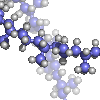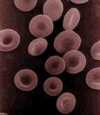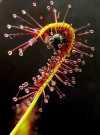 Both DNA and plastic, two seemingly unrelated materials, are classified as polymers, compounds of usually high molecular weight consisting of a number of structural units linked together by covalent bonds. A diverse assortment of natural and synthetic materials comprises the class of polymers, including hair, polyester, and shellac. Polymers are even used in the production of microprocessor parts. What is the process that produces polymers called? Discuss
Both DNA and plastic, two seemingly unrelated materials, are classified as polymers, compounds of usually high molecular weight consisting of a number of structural units linked together by covalent bonds. A diverse assortment of natural and synthetic materials comprises the class of polymers, including hair, polyester, and shellac. Polymers are even used in the production of microprocessor parts. What is the process that produces polymers called? Discuss
Source: The Free Dictionary
 Once solely a concept of science-fiction, the parahuman, or human-animal hybrid, has recently entered the realm of reality. Efforts to combine genes from different species for medical and industrial purposes are now fairly common. Though such research could prove useful for the production of drugs and transplant-ready organs, it has raised numerous ethical, moral, and legal issues. Have scientists created human-animal hybrid embryos?
Once solely a concept of science-fiction, the parahuman, or human-animal hybrid, has recently entered the realm of reality. Efforts to combine genes from different species for medical and industrial purposes are now fairly common. Though such research could prove useful for the production of drugs and transplant-ready organs, it has raised numerous ethical, moral, and legal issues. Have scientists created human-animal hybrid embryos?  Characterized by the consumption of materials such as soil, chalk, and hair, pica is a disorder involving an appetite for non-nutritive substances or an abnormal compulsion to eat foodstuffs that are usually ingredients, such as flour or starch. Such eating behaviors have been observed in people of all ages but are only termed pica if they persist for more than one month in persons deemed developmentally able to determine whether an item is appropriate for consumption. How is pica treated?
Characterized by the consumption of materials such as soil, chalk, and hair, pica is a disorder involving an appetite for non-nutritive substances or an abnormal compulsion to eat foodstuffs that are usually ingredients, such as flour or starch. Such eating behaviors have been observed in people of all ages but are only termed pica if they persist for more than one month in persons deemed developmentally able to determine whether an item is appropriate for consumption. How is pica treated?  Often considered the most-viewed total solar eclipse in human history, the eclipse of August 11, 1999, was the first total eclipse visible from Europe in nearly a decade. The path of the moon’s shadow began in the Atlantic Ocean just before noon and traversed England, France, Germany, Austria, Hungary, and Serbia before reaching maximum coverage in Romania and continuing across Bulgaria, the Black Sea, Turkey, Iran, Pakistan, and India. What spacecraft also observed the moon’s shadow?
Often considered the most-viewed total solar eclipse in human history, the eclipse of August 11, 1999, was the first total eclipse visible from Europe in nearly a decade. The path of the moon’s shadow began in the Atlantic Ocean just before noon and traversed England, France, Germany, Austria, Hungary, and Serbia before reaching maximum coverage in Romania and continuing across Bulgaria, the Black Sea, Turkey, Iran, Pakistan, and India. What spacecraft also observed the moon’s shadow?  Usually found in places with thin or nutrient-poor soil, carnivorous plants derive some or most of their sustenance by attracting, trapping, and digesting insects, small animals, and protozoans. Though there are hundreds of species of carnivorous plants, they all attract and trap prey using any of 5 basic mechanisms: pitfall traps, flypaper traps, snap traps, bladder traps, and lobster-pot traps. Just two species are classified as “active” snap traps; one is the Venus flytrap, what is the other?
Usually found in places with thin or nutrient-poor soil, carnivorous plants derive some or most of their sustenance by attracting, trapping, and digesting insects, small animals, and protozoans. Though there are hundreds of species of carnivorous plants, they all attract and trap prey using any of 5 basic mechanisms: pitfall traps, flypaper traps, snap traps, bladder traps, and lobster-pot traps. Just two species are classified as “active” snap traps; one is the Venus flytrap, what is the other?  Widely used in thought experiments—imagined scenarios whose outcomes are reasoned but not physically played out—philosophical zombies are hypothetical beings indistinguishable from normal humans in all but one respect—they lack conscious experience. This quality makes the “p-zombie” an ideal subject for philosophical musings. According to physicalism, everything that exists is ultimately physical. How have philosophers used these hypothetical beings in arguments disputing this perspective?
Widely used in thought experiments—imagined scenarios whose outcomes are reasoned but not physically played out—philosophical zombies are hypothetical beings indistinguishable from normal humans in all but one respect—they lack conscious experience. This quality makes the “p-zombie” an ideal subject for philosophical musings. According to physicalism, everything that exists is ultimately physical. How have philosophers used these hypothetical beings in arguments disputing this perspective?  In 2005, the Japanese Ministry of the Environment launched the Cool Biz campaign, a program intended to reduce electricity consumption by limiting air conditioner use. Government offices were asked to set their air conditioners to 82°F (28°C), and workers were advised to wear short-sleeved shirts to keep cool. According to estimates, the campaign resulted in a 460,000-ton reduction in carbon dioxide emissions—the equivalent of shutting down some 1 million households for what period of time?
In 2005, the Japanese Ministry of the Environment launched the Cool Biz campaign, a program intended to reduce electricity consumption by limiting air conditioner use. Government offices were asked to set their air conditioners to 82°F (28°C), and workers were advised to wear short-sleeved shirts to keep cool. According to estimates, the campaign resulted in a 460,000-ton reduction in carbon dioxide emissions—the equivalent of shutting down some 1 million households for what period of time?  Sometimes used to treat skin conditions, mood disorders, and sleep disorders, light therapy consists of exposure to specific wavelengths of light for a prescribed amount of time. Visible violet light is used to activate a naturally occurring compound that kills acne-causing bacteria, while sunlight-mimicking light boxes and other infrared lights are used to treat seasonal affective disorder, a winter-related depressive disorder. What travel-related affliction is also treated with light therapy?
Sometimes used to treat skin conditions, mood disorders, and sleep disorders, light therapy consists of exposure to specific wavelengths of light for a prescribed amount of time. Visible violet light is used to activate a naturally occurring compound that kills acne-causing bacteria, while sunlight-mimicking light boxes and other infrared lights are used to treat seasonal affective disorder, a winter-related depressive disorder. What travel-related affliction is also treated with light therapy?  In the 1970s, widespread fear of imminent natural and artificial disasters and societal collapse led to the development of survivalism, a subculture based on the anticipation of catastrophic events and the preparations involved in surviving disaster. The movement is still popular today. Survivalists stockpile food and water, build shelters, and learn skills that they believe will help them live through apocalyptic chaos. In survivalist terminology, what is a “BOB”?
In the 1970s, widespread fear of imminent natural and artificial disasters and societal collapse led to the development of survivalism, a subculture based on the anticipation of catastrophic events and the preparations involved in surviving disaster. The movement is still popular today. Survivalists stockpile food and water, build shelters, and learn skills that they believe will help them live through apocalyptic chaos. In survivalist terminology, what is a “BOB”?